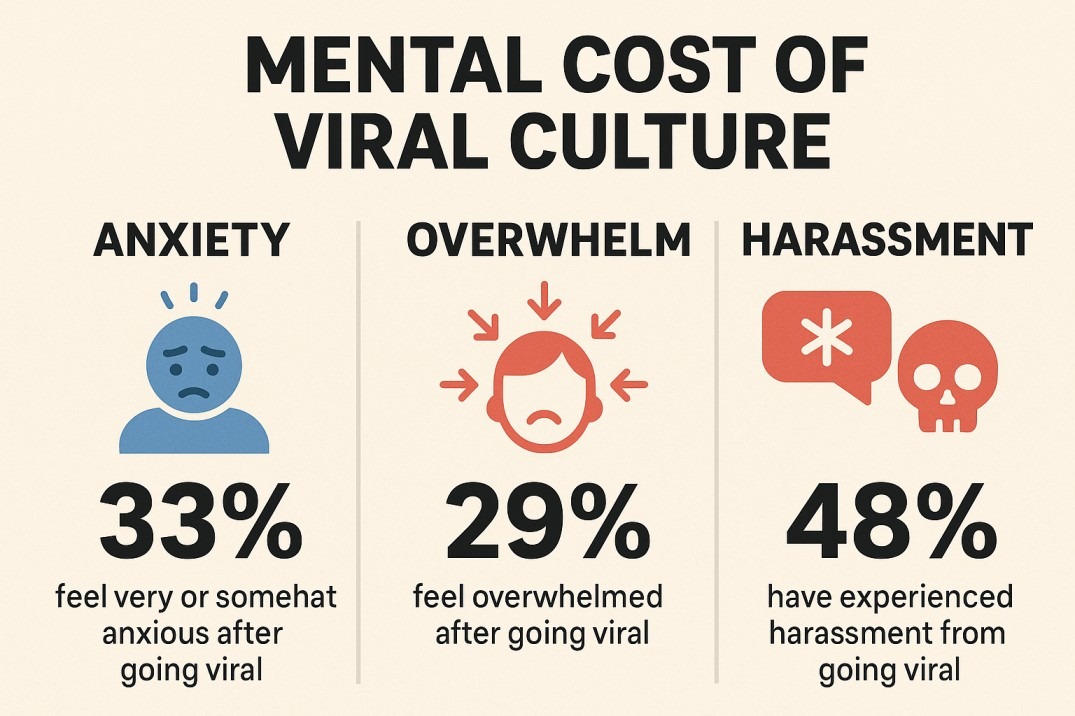A quirky video, a clever meme, or a compelling story could rise to fame purely through public fascination and grassroots sharing. It was the digital version of word-of-mouth, democratized by social networks and amplified by curiosity. But as platforms evolved—and monetization became the priority—that organic model was quietly replaced. Today, virality isn’t just unpredictable; it’s engineered. And the platforms we rely on for discovery are no longer neutral stages but algorithmic puppeteers pulling the strings behind every viral hit.
The Illusion of Organic Virality
At a glance, content that goes viral seems to do so spontaneously. A TikTok of a dog dancing. A thread on X that unpacks a bizarre story. A single Instagram reel that gets millions of views overnight. But when we peer behind the curtain, we find a system designed not for quality or creativity but for retention and ad revenue.
Platforms like YouTube, Facebook, TikTok, and Instagram decide what surfaces—and what sinks—through opaque recommendation engines. These aren’t neutral suggestions based on merit; they are decisions made by code written to maximize time-on-platform. The goal isn’t authentic virality anymore. It’s optimized virality, where content is selected, promoted, and looped based on engagement triggers, not genuine resonance.
Algorithms Reward Manipulation
In the age of platform dominance, virality meaning has taken a sharp turn from organic excitement to cold, calculated design. The algorithms that govern social media feeds and content discovery have become more than just neutral tools—they’re gatekeepers of attention. And increasingly, they reward manipulation over merit.
The Art of Gaming the System

Understanding the virality meaning today requires examining what the algorithm values. Platforms like TikTok, Instagram, YouTube, and X no longer prioritize substance; instead, they reward emotional provocation, brevity, and novelty. Creators who have mastered this meta-game use tactics like clickbait thumbnails, rage-bait headlines, and controversial framing to provoke rapid engagement.
A carefully staged moment—whether it’s someone yelling into a camera or a bait-and-switch reveal—doesn’t just perform well by accident. It’s engineered to spike the algorithm’s engagement metrics: retention, comments, shares, and replays. Those who know how to exploit these signals can manufacture virality meaning at will.
Slot Machines, Not Stories
This shift has blurred the line between content creation and behavioral manipulation. Videos are now crafted less like stories and more like slot machines, with the payoff being dopamine and digital currency—likes, shares, followers. It’s not about telling a compelling narrative or sharing something deeply meaningful. It’s about triggering just the right neural pathway to keep users scrolling.
The virality meaning of this new model incentivizes creators to reduce complexity, flatten nuance, and strip context. What works is what sticks. And what sticks is often shallow, shocking, or polarizing. The tragedy? Thoughtful content—slow, introspective, or educational—gets buried beneath a tsunami of sensationalist junk.
The Death of Authentic Engagement
Once upon a time, virality meaning was tied to genuine excitement. A video of a wedding proposal, an impassioned speech, or an ingenious DIY hack could go viral because people truly wanted to share it. That spirit hasn’t vanished entirely, but it’s been overshadowed by manipulation masquerading as engagement.
Now, content doesn’t spread because people love it—it spreads because they were tricked into reacting. Emotional hijacking is the new norm. Instead of offering value, much of today’s viral media seeks to generate outrage, lust, pity, or tribal affirmation. These aren’t conversations. They’re reflexes.
Cultural Influence in the Algorithmic Age
What does virality meaning imply for cultural power? It’s simple: platforms decide what we see, and creators adapt to their rules. This feedback loop concentrates influence in the hands of those who are best at manipulating systems, not those who are best at producing ideas. That’s a massive transformation in how culture flows.
It also creates an incentive structure that punishes depth and rewards intensity. Quiet voices get drowned out. Nuanced arguments get skipped. In their place, loud, simplistic, and binary content rises. Cultural literacy takes a back seat to algorithmic literacy.
Redefining Virality, Before It Redefines Us
If we don’t examine virality meaning critically, we risk becoming pawns in someone else’s attention war. Platforms are not passive. They are curators—designing reality for billions of people. When virality is no longer driven by meaning but by manipulation, the internet becomes a hall of mirrors: addictive, distorted, and emotionally exhausting.
To counter this, we need to rethink how we measure success online. Is a million views worth it if it was built on deception? Is popularity meaningful if it’s detached from purpose?
As creators and consumers, the answer lies in reclaiming virality meaning—not as a tool for exploitation, but as a reflection of resonance, creativity, and shared value.
The Platform’s Agenda
We often forget that platforms have incentives of their own. Facebook wants you angry and commenting. YouTube wants you deep in a content spiral. TikTok wants you to swipe forever. These desires shape the rules of engagement—and therefore what becomes viral.
It’s why emotionally intense content tends to go viral more easily. Outrage, awe, disgust, and shock outperform nuance, reason, and balance. Because the algorithm isn’t looking for truth; it’s measuring time, taps, and returns. In this environment, virality isn’t just broken—it’s weaponized.
What you see trending may not reflect what most people find interesting. It reflects what the algorithm believes will keep people hooked. In turn, that creates a feedback loop where creators tailor their content not for humans, but for machines that influence humans. And that distortion is felt across culture, media, politics, and even mental health.
Virality and the Echo Chamber Effect
Another casualty of the broken virality system is diversity of thought. Algorithms favor content similar to what you’ve already engaged with, leading to increasingly narrow content diets. This echo chamber effect means that what goes viral in one circle might be completely invisible in another.
Virality used to be about wide appeal. Now it’s about targeted saturation. That’s not inherently bad, but it undermines the idea of the internet as a public square where the best ideas rise to the top. Instead, each community exists in a microcosm of its own curated “viral” content—making social cohesion harder and online polarization worse.
Moreover, controversial content thrives under this model because it triggers more engagement. The result? A landscape where the most divisive topics are pushed to the forefront while more balanced, meaningful voices are drowned out.
The Mental Cost of Viral Culture

The broken state of virality doesn’t only shape what we see—it shapes how we behave. Content creators feel immense pressure to produce material that conforms to platform trends, no matter their original vision. This can lead to burnout, creative fatigue, and mental health struggles.
The fleeting nature of virality also means creators can go from obscurity to internet fame—and back to irrelevance—in the span of a week. There’s no consistency, no roadmap, and no guarantees. Some creators become addicted to chasing virality, refreshing analytics in the middle of the night, altering their identity to please algorithms they don’t understand.
Even for viewers, the effects aren’t benign. The dopamine hit from viral content has been compared to a drug. Users get hooked on novelty, on stimulation, on bite-sized emotion. And just like any addiction, tolerance builds. Yesterday’s viral hit seems dull today. Tomorrow needs to be louder, faster, angrier.
When Virality Becomes Propaganda
Perhaps the most alarming consequence of broken virality is its vulnerability to manipulation by bad actors. Coordinated disinformation campaigns, political astroturfing, and influencer fraud all exploit the very algorithmic biases that platforms deny exist.
The viral success of misleading content is no accident. Whether it’s election misinformation, health conspiracies, or deepfakes, these messages are crafted with algorithmic virality in mind. And because platforms are slow to act—or fear losing engagement—they often let harmful content spread unchecked until public outcry forces a response.
In this sense, virality isn’t just broken—it’s dangerous. It can be weaponized to shape public opinion, spark unrest, or undermine democratic processes.
Reclaiming Meaningful Sharing
The Illusion of Modern Virality
So where do we go from here? Can we fix virality?
First, we need to admit the truth: virality, as we understood it in the early 2010s, is gone. What we have now is a simulacrum—an imitation of spontaneous cultural excitement that’s been carefully engineered. Today’s virality is less about genuine enthusiasm and more about algorithmic optimization. Platforms reward content that triggers predictable engagement loops: outrage, clickbait, controversy, or sensationalism. But recognizing this manipulated architecture is the first step toward regaining control.
The Creator’s Shift: From Metrics to Meaning
If creators want to reclaim authenticity, they must shift their focus from chasing numbers to cultivating community. This means building relationships, not just reach. Platforms can (and will) change their rules overnight, but the trust you’ve earned with your audience remains portable.
Creators who prioritize conversation over spectacle, substance over shock, and depth over virality may grow more slowly—but they’ll grow with stability. A dedicated group of 500 people who care is worth more than 50,000 fleeting views. Meaningful engagement may not trend, but it endures.
Platform Responsibility: Beyond Engagement Metrics
We must also demand accountability from the platforms themselves. These systems are not neutral. The algorithms behind TikTok, YouTube, Instagram, and others are designed to maximize retention and ad revenue—not truth, not well-being, not creativity. When virality is dictated by opaque mathematical formulas, creators are essentially dancing for a machine.
Public pressure is not enough. Transparency in algorithm design, third-party audits, and government oversight must be put on the table. If social platforms can influence elections, public health, and global narratives, then the public deserves insight into—and recourse against—the mechanisms of manipulation.
The User’s Role: Conscious Consumption
Perhaps the most overlooked actor in the virality equation is you. The user. The viewer. The scroller.
Virality thrives on passivity. On default settings. On the mindless share. But what if we slowed down and questioned each viral moment that comes across our feed?
- Why is this in front of me?
- Who benefits from me engaging with this?
- Does this actually matter—or does it just feel urgent because of how it was presented?
By shifting from passive to intentional consumption, users can start disrupting the very dynamics that allow meaningless virality to thrive.
Toward a Healthier Internet Culture
Reclaiming meaningful sharing isn’t about turning away from technology—it’s about changing our relationship with it. The goal isn’t to destroy virality but to refine it, to realign it with values that matter: truth, creativity, connection, and context.
If we succeed, virality could once again become a signal of something worth sharing—not just something easy to click.
Final Words
Virality isn’t inherently bad. In fact, it remains one of the internet’s most powerful tools. It can elevate voices that would otherwise go unheard. It can spark movements, raise funds, save lives. But to harness that power, we must remove it from the clutches of platforms whose interests are not aligned with ours.
In its current form, virality is broken because it’s no longer about what resonates. It’s about what retains. And that distinction matters. Until we reimagine virality in a way that values truth, diversity, and integrity, we’ll continue to be at the mercy of invisible algorithms shaping not just what we see—but who we become.
Andrea Balint is a writer and researcher focused on human behavior, workplace psychology, and personal growth. Through her work at CareersMomentum, she explores how mindset, leadership, and emotional intelligence shape modern careers. With a background in communication and HR development, she transforms complex ideas into practical insights that help readers build clarity, confidence, and professional purpose.
